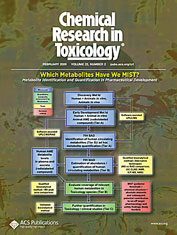 | |
| Discipline | Chemistry, toxicology |
|---|---|
| Language | English |
| Edited by | Shana J. Sturla |
| Publication details | |
| History | 1988-present |
| Publisher | American Chemical Society (United States) |
| Frequency | Monthly |
| 4.1 (2022) | |
| Standard abbreviations | |
| ISO 4 | Chem. Res. Toxicol. |
| Indexing | |
| CODEN | CRTOEC |
| ISSN | 0893-228X (print) 1520-5010 (web) |
| Links | |
Chemical Research in Toxicology is a peer-reviewed scientific journal, published since 1988 by the American Chemical Society.[1] It is currently abstracted and indexed in Chemical Abstracts Service, Scopus, EBSCOhost, PubMed, CABI, Science Citation Index Expanded, and SwetsWise.
As of January 2018, the editor-in-chief is Shana Sturla (Institute of Food, Nutrition, and Health Department of Health Sciences and Technology ETH Zurich).[2]
According to the Journal Citation Reports, the journal had a 2022 impact factor of 4.1.[3]
References[edit]
- ^ About the Journal, Washington: American Chemical Society, 2009.
- ^ Editor Profile, Washington: American Chemical Society, 2022.
- ^ "Chemical Research in Toxicology". 2022 Journal Citation Reports. Web of Science (Science ed.). Thomson Reuters. 2023.
Well, that’s interesting to know that Psilotum nudum are known as whisk ferns. Psilotum nudum is the commoner species of the two. While the P. flaccidum is a rare species and is found in the tropical islands. Both the species are usually epiphytic in habit and grow upon tree ferns. These species may also be terrestrial and grow in humus or in the crevices of the rocks.
View the detailed Guide of Psilotum nudum: Detailed Study Of Psilotum Nudum (Whisk Fern), Classification, Anatomy, Reproduction